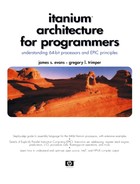Chapter 5
| A1: | Among other factors, you might consider how many clock cycles are needed and how any two-step schemes are protected in the case of CPU interrupts. |
| A3: | How, for instance, is branch range determined? About how many bits would be required for a subcode to encode both integer and floating-point relations? |
| A4: | Yes. |
| A5: | Not equal is not equal (i.e., to zero), independent of interpretation of the bit pattern. |
| A6: | How many predicate registers are available (see Appendix D)? Could an inner compare instruction “unconditionally” modify the same predicate register that predicated that instruction itself? |
| A7: | It falls through only on the final traversal. |
| A8: | Infinite loop. |
| A9: | Consider the program in Figure 5-1 and substitute a subtract operation for the multiply operation. What other modifications would be needed for the specified situation? |
| A13: | What is the maximum amount of multiplication achievable using one shladd instruction? |
| A15: | Either A or D. Why? |
| A18: | Begin from MAXIMUM as a model program, but look instead for a minimum value. |
..................Content has been hidden....................
You can't read the all page of ebook, please click here login for view all page.
